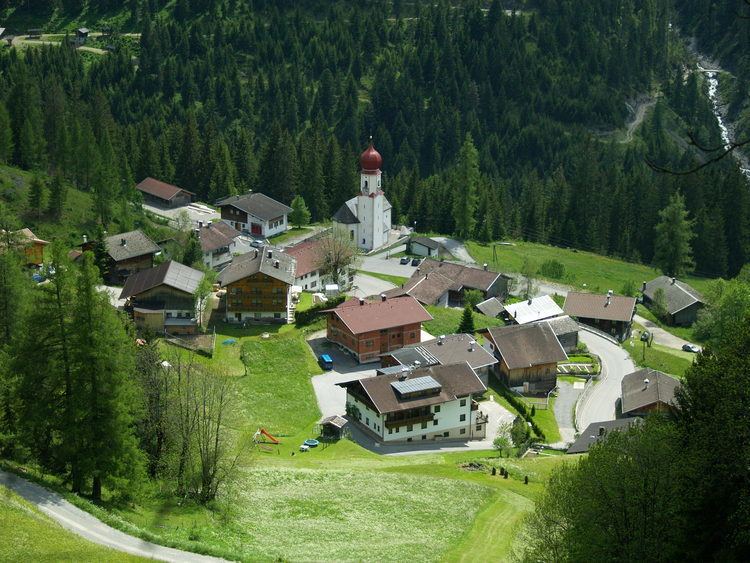Elevation 1,314 m | ||
 | ||
Bschlabs is a small community in the Austrian municipality of Pfafflar, Bschlaber Valley, which consists of about 70 buildings with about 90 residents. These buildings make up the village of Bschlabs itself and the hamlets Aschlen, Sack, Windegg, Mitteregg, Taschach, Egg, and Zwieslen. The town is the municipal seat of Pfafflar. Bschlabs is located on the southern slope of the Namloser Weathertop with an elevation of 2,553 metres (8,376 ft) in the valley opposite of the Spitzkopf (2,346 metres (7,697 ft). Currently, Bschlabs is decreasing in population along with Pfafflar as a whole.
Contents
- Map of 6647 Bschlabs Austria
- History
- Names
- Sanctuary Maria Snow
- The Senses Trail
- Bschlaber song
- References
Map of 6647 Bschlabs, Austria
History
The Pfafflar valley was settled by Engadine religious refugees. The settled area is composed of the three widely spaced districts or localities Bschlabs, Boden, and Pfafflar in the Bschlabertal valley, a side valley of the Lechtal valley. Pfafflar was mentioned for the first time in 1300 AD as “Pavelaers”, which is based on the Latin term “pabularium” (alpine pasture, pasture ground) or “pabulariu” (feeding stable). The three hay barns on the emblem of the municipality represent both the name of the municipality and the three villages that make up the municipality: Bschlabs, Boden and Pfafflar. Up to the 20th century the parish estate was also a tavern called “Zur Gemütlichkeit”.
Names
In 1284, the village was called Bislafes. This was later changed to Pislaves and was modified to Piselaves, Pshlavess or Pischlaabz.
The name derives from pos & l'aves ("behind the waters"), likely due to the confluence of Streimbach and its tributaries.
Sanctuary Maria Snow
The church was built in 1639 as a chapel and consecrated in 1648 by the auxiliary bishop of Brixen. Before the construction of the church, the dead had to after Dormitz (at Nassereith) and are later taken to Imst and buried there. 1670 was the first chaplain, Nicholas Kranebitter, in this valley, was 40 years priests in Bschlabs and was buried beneath the altar. The records of the oldest Taufbuches in the parish, start with the 31 October 1670.
The church is the beginning of the 18th century been enlarged. The tower was built from 1770 to 1780, with an octagonal floor and onion dome. 1857 they built a sacristy to. Two years later, the high altar was built. In the middle, instead of a painting, the figure of grace Madonna and Child; in addition to the double row of columns, the figures of the apostles, left Paul, right Peter and two other saints (all of Josef Georg Witwer 1775). High Tabernakelvorbau with columns position and Rundtempelbau; in the round niches statuettes. Left of Barbara and Ignatius, the right of John Nepomuk and Katharina (from Josef Anton racing).
The side altars: Building 1884 left side altar with guardian angel painting, on the right side altar painting St. Joseph with Jesus on both sides with putti (widower Werkstätte). The pulpit: mid 19th century in the fields Jesus and Mary monogram, symbols of divine virtues, Holy Eucharist, law panels with sword and palm.
The cross above the sacristy entrance is from Balthasar Jais from Imst (1740). In the glass display cases: left, Madonna clothed with Child, 18th century; right, Lady with blue star mantle (was supported in processions). The stained glass of the top and bottom semicircular closed church windows from the Tyrolean Stained Glass Innsbruck (1919) represent the Annunciation, Visitation, and Nativity.
Parapet Organ with beautiful rococo prospectus (organ works from the 18th and 19th centuries). The people's altar, with a picture of the Last Supper, is by Gottlieb Praxmarer from Häselgehr.
There are two old frescoes (Crucifixion and St. Christopher), which were discovered during the renovation of the church on the outer facade of the church. The renovated sanctuary was re-consecrated in 1985 by Bishop Dr. Paul Rusch. The patronal feast is on August 5.
This chapel is located at the so-called Gröbegg at Bschlabs / Aschlen the old footpath from Elmen to Bschlabs. It was probably built in the early 20th century, was largely forfeited, and was renovated in 1988
The Senses Trail
The "Way of the Senses" is a walk starting just below the church in Bschlabs, leading through a forest down to the Streimbach over a suspension bridge and on shady up at the forest. Along the way are works of art made of wood, metal, and stone with contemplative sayings, designed by local artists. The stations with pictures can be found on the homepage of the community Pfafflar under the item Attractions.
Bschlaber song
A song was written about the small town of Bschlabs. The melody and the text submitted by Gerhard Hackenbuchner. The text of native song:
